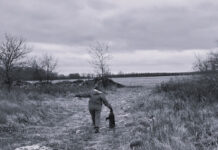Your new neighbors might not be the ones you can see, but they can often be heard after dark, singing a scary tune, a song that can bring the hair on one’s neck to attention.
In fact, these new neighbors are usually crude and secretive — traits you might not approve of — and you most certainly won’t encourage your children to play with their youngsters, who behave like animals — biting, wrestling, and chasing each other around.
More so, it’s a sure bet you are going to want your new neighbors to be your old neighbors, and the sooner the better. That’s the way it is all too often when one of more coyotes move in.
Specialists
Who better to tell you how to handle this annoying situation than the tag team of Jamey Emmert and Laura Graber, Ohio Division of Wildlife information specialists?
Both agree coyotes are so numerous in Ohio they will all too often take up residence in towns, cities and housing developments. One of nature’s most adaptive creatures, wild coyotes, seek food sources and shelter, things easily available near humans and a lot less work to find than in the forest.
But to be sure, when they move in, they bring with them a large degree of fear but a lesser real threat.
Key
According to Emmert, the key is to focus your efforts on one coyote, the one you know to be nearby and unwelcome. You will never get results if your efforts are meant to eliminate all coyotes, because it isn’t going to happen — never has and never will.
Nevertheless, when coyotes or any wild animals loose their fear of humans they do become nuisances.
In the wild, coyotes eat nearly anything, with more than 40 percent of their diet consisting of small rodents such as mice and moles. Next come deer, at just a little more than 20 percent.
Add to that birds, rabbits, groundhogs and vegetation. Then toss in an occasional cat or small dog, as well as pet food and garbage.
Cat versus coyote
An Arizona study documented 36 interactions between coyotes and cats, with 19 of the cats becoming coyote lunch.
Ohio’s coyotes average about 35 pounds, but can appear much larger with a full winter coat. They breed in late winter and are most vocal during the breeding season. Pups are born two months after breeding.
Tips
To get rid of a troublesome coyote, Emmert suggests removing every possible attractant and harassing the unwanted critter to encourage them to leave, but more often the end result is a need to eliminate the pest, and that means seeking the help of a nuisance trapper for most folks.
Coyotes cannot be relocated or tamed, so don’t expect a wildlife official to assist or offer help other than suggestions.
One thing is for sure, said Graber, coyotes won’t leave on their own. They must be encouraged to find more friendly territory.












